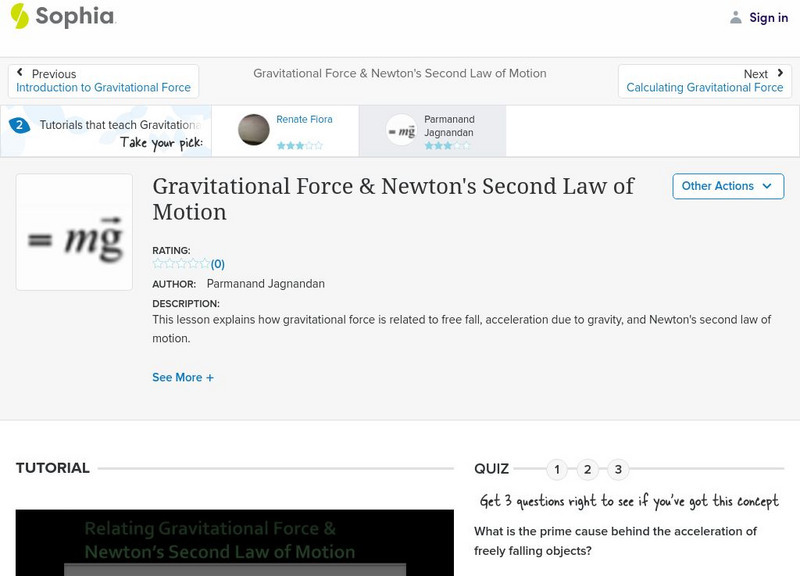Physics Classroom
The Physics Classroom: Cavendish and the Value of G
A short description of how Cavendish measured the value of G - the universal gravitation constant and supported Newton's theory. Illustrated.
Sophia Learning
Sophia: Gravitational Force & Newton's Second Law of Motion
This lesson explains how gravitational force is related to free fall, acceleration due to gravity, and Newton's second law of motion.
University of St. Andrews (UK)
University of St. Andrews: Isaac Newton (1643 1727)
This life of Isaac Newton' traces his life from birth through childhood to his rise as a renown scientist and mathematician.
Khan Academy
Khan Academy: What Is Weight?
This article on weight will help you prepare for the AP Physics test. Included are example problems to help you practice.
University of Minnesota
University of Minnesota: Mechanics Problems: Force and Linear Kinematics Problem
This University of Minnesota site provides a series of contextually rich problems pertaining to force, Newton's second law of motion, and linear kinematics.
TeachEngineering
Teach Engineering: How Do Things Fall?
Students learn more about forces by examining the force of gravitational attraction. They observe how objects fall and measure the force of gravitational attraction upon objects.
Texas Education Agency
Texas Gateway: 4.8 Extended Topic: The Four Basic Forces: An Introduction
By the end of this section, you will be able to understand the four basic forces that underlie the processes in nature: gravitational, electromagnetic, weak nuclear, strong nuclear forces.
Upper Canada District School Board
Tom Stretton's Chemistry Pages: Universal Gravitation
Deepen your understanding about the Law of Universal Gravitation. Find out how the many scientists throughout history contributed to one of the most widely known scientific theories.
Physics Classroom
The Physics Classroom: Satellite Motion
An animation depicting the path of projectiles launched at various launch speeds from the fictional Newton's Mountain. Accompanying text discusses satellite motion and the requirements of orbital motion. Links to further information is...
Physics Classroom
The Physics Classroom: Free Fall and Air Resistance
This lesson in high school physics on Newton's Second Law of Motion provides a discussion of free fall and air resistance, and answers, "Why do objects which encounter air resistance ultimately reach a terminal velocity?" and "In...
Georgia State University
Georgia State University: Hyper Physics: Conservation of Energy
This site is from the Physics Department at Georgia State University. The conservation of energy as a fundamental conservation law is presented and compared to other conservation laws (momentum and angular momentum). Links to further...
Curated OER
Etc: Clip Art Etc: Death Mask of Sir Isaac Newton
The death mask of Sir Isaac Newton, who discovered the law of gravitation.
Libre Text
Libre Text: Pressure Gradients
From high school geography class, you may remember that "air tends to flow from high pressure to low pressure". To understand why this happens, it is key to realizing that gasses (but also liquids) exert a force on their surroundings...
Georgia Department of Education
Ga Virtual Learning: A Brief History of Astronomy
In this interactive module students will explore what different ancient cultures believe was an explanation of the stars and planets. They will look at how the work of Nicolas Copernicus revolutionize the world of astronomy and learn how...
Georgia Department of Education
Ga Virtual Learning: Ap Physics 1: Gravity
Combined with aspects of circular motion, students discover that Kepler's third law follows directly from the law of universal gravitation. This unit will expand upon the conservation of energy principle for problems beyond the confines...
University of Colorado
University of Colorado: Ph Et Interactive Simulations: Gravity Force Lab
An interactive simulation that teaches about gravitational force, Newton's Third Law, and force pairs by varying properties affect the gravitational force exerted between two objects. This simulation can either be downloaded or played...
Vision Learning
Visionlearning: Mechanics: Gravity: Newtonian Relationships
Explanation of how astronomers and scientist developed the current theories of gravity.
University of Colorado
University of Colorado: Ph Et Interactive Simulations: Gravity Force Lab
Manipulate the mass and distance of two objects to see how these properties change the gravity force.
CK-12 Foundation
Ck 12: Fifth Grade Science: Earth Science: Gravity
Do you know how gravity affects you? This module defines gravity and explains how gravity affects the motion of objects.
Walter Fendt
Walter Fendt: Projectile Motion
A short interactive activity to show the movement of a projectile. You can change the values of the initial height, velocity, angle of inclination, the mass and the gravitational acceleration.
Science Education Resource Center at Carleton College
Serc: Water Bottle Rockets Understanding Energy
In this activity, learners will design and construct a water bottle rocket. Students will demonstrate understanding of a good experimental design and analysis of results.
Science4Fun
Science4 Fun: Force
What is force? Illustrated discussion of how force is calculated and three familiar types.
Khan Academy
Khan Academy: What Is a Centripetal Force?
Learn what centripetal forces are and how to calculate them. Included are two problems with the solutions provided.
Other
Wikibooks: Physics Study Guide
A handy resource that gives an overview of equations and definitions pertinent to an introductory, college-level physics course, with two of its three sections focusing on motion-related topics and principles.


















